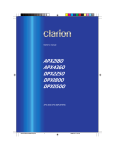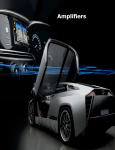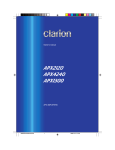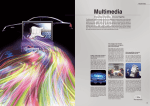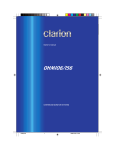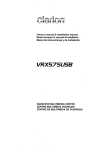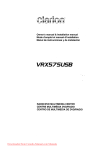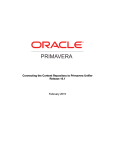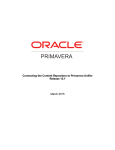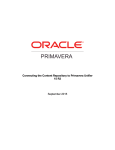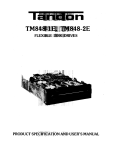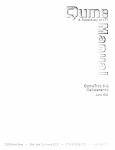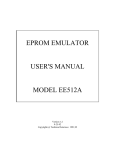Download Clarion APX1300 Specifications
Transcript
Amplifiers Amplifiers 2007 Amplifier Line Overview Clarion amplifiers were designed from the ground up to compliment one-another in terms of features, performance and design. The 2007 amplifier line takes a three tiered approach to features, technology and design. Model APX2120 APX4240 APX1300 APX2180 APX4360 DPX2250 DPX1800 DPX11500 Class AB AB AB AB AB G G G Description 2-Channel 4-Channel Mono 2-Channel 4-Channel 2-Channel Mono Mono Power 2 x 60W 4 x 60W 1 x 300W 2 x 90W 4 x 90W 2 x 125W 1 x 800W 1 x 1500W The entry-level amplifiers offer increased power production over previous models, as well as featuring a cosmetic theme that integrates with the top two amp series. The feature set on our entry level amplifiers was designed to allow installers to get these amps installed into a vehicle quickly and tune them without the need for complex instruction manuals. These features allow for elaborate system design and configuration. The top two series of amplifiers (Illuminated and Class G) are designed around a set of features that allow for more accurate installations, class leading transparency, dynamics, musicality and efficiency. The APX2180 and APX4360 offer benchmark sonic transparency, frequency and phase response and installation / configuration features. The new DPX amplifiers feature stateof-the-art Class G designs that offer the ultimate mix of sound quality and efficiency, minimizing the load on a vehicle's electrical system. Precise Frequency Selector Electronic Crossover The inclusion of an electronic crossover in an amplifier allows for efficient setup and configuration of an audio system. It also allows that amplifier to be used with factory or after market source units that do not have electronic crossovers in them. Finally, the electronic crossover can be used to maximise the performance of the speaker(s) it is powering. One drawback of a conventional electronic crossover is that it can be difficult to precisely set the crossover frequency because the potentiometer is nearly infinitely adjustable. Many crossover controls are only labelled at the top and bottom of its frequency range, making selecting something in the middle even more difficult. Clarion provides a simple and elegant solution for accurately setting crossover points with our PFS (Precise Frequency Selector) crossover adjustment. The potentiometer on the APX2180, APX4360, DPX2250, DPX1800 and DPX11500 amplifiers has 41 detented positions. Using the supplied charts, you can select a specific crossover frequency, then to set it, turn the adjustment potentiometer the according number of clicks, and you are done. One of the many benefits of this feature surfaces when you are building a multi-amp system. With conventional crossover controls, you could end up setting a subwoofer amp to 70Hz when you were aiming for 85Hz and end up at 100Hz on the mids and highs amp. The result would be a system that lacks dynamics and sounds muddy. PFS makes accidental under- or over-lapping of crossovers a thing of the past. Input Voltage Selector Gain Control Conventional gain adjustment systems have inherent limitations. Because users want a wide sensitivity range (0.2V to 8.0V for example), a conventional gain control causes large differences in left and right 64 Amplifiers – Technologies output - called channel imbalance. This is due to variances and tolerance limitations on the potentiometer used to make the adjustment. IVS dramatically reduces channel imbalance by implementing three gain ranges, 0-0.6v, 0.6-2v, 28v. The result is a reduction in maximum potential channel imbalance, better imaging and a more accurate soundstage. This graph shows the amount of channel imbalance from two identical amplifiers, one with IVS and one without, The curve with the large bump is the amplifier without IVS and reaches a maximum channel imbalance of 0.75dB at 0.25% of maximum gain. The two overlapping curves show the channel imbalance of an IVS-equipped amp at the 0.6-2V and 2V-8V settings. The maximum imbalance is only 0.45dB - half of the non-IVS amplifier. what a Clarion customer demands. The operation of a Class G amplifier is very simple. Traditional amplifiers use a Class AB output device topology. Essentially, there are a set of switching devices (transistors) for the positive half of the waveform and another set for the negative half of the waveform. These devices operate linearly, passing more current through them as more signal is sent to them. The drawback with a Class AB topology is that the output devices operate in their resistive region, rarely fully on or off. This results in a great deal of heat being generated and energy wasted. Around a decade ago, the introduction of Class D amplifiers to the car audio market showed a marked improvement in amplifier efficiency at the expense of sound quality and control. Class D amplifiers operate by cycling the output devices fully on and off very quickly, and adjusting the on vs off time to effect a change in output level. One of the many drawbacks of Class D amplifiers is that they require large filtering networks after the output stage to clean up the signal and remove high frequency switching noise. Class D amplifiers can Why not individual gain controls? While individual gain controls can offer very accurate sensitivity settings, an installer MUST use an oscilloscope or voltmeter to properly set these controls for accurate channel to channel output. Clarion has made every effort possible to reduce installation time and complexity. Class G Amplifiers Amplifier efficiency has never been more important than it is in today's modern vehicles. Alternators, batteries and factory wiring are smaller than ever to produce the lightest and most fuel efficient vehicles possible at the lowest cost. Clarion Class G amplifiers are the results of years of design and testing to offer the optimum balance of sound quality and efficiency - exactly Class G Amplifier Red (outside) - Power Supply Voltage Blue (Sine Wave) - Output Waveform cause significant electrical interference that can affect radio reception. A Class G amplifier is truly the best of both worlds. Clarion’s Class G DPX amplifiers use a Class AB audio path with a hybrid Class G 65 Amplifiers – Technologies multi-voltage power supply. The result is tight, controlled, dynamic power output with excellent amplifier efficiency. How does Class G work? Think of the new Dodge Hemi or Cadillac Northstar engines. These engines have the ability to shut down a number of cylinders to reduce fuel comsumption and heat generation under light loads. The power supply of a Class G amplifiers works in exactly the same way. When you aren’t cranking on the amp, the power supply rail voltage turns down. The effect, less current is passed through the output devices, dramatically reducing wasted power. The graph below compares the efficiency of a conventional Class AB 1500W amp to our DPX11500 Strappable Power The DPX1800 and DPX11500 amplifiers are both strappable. This means, a pair of amplifiers can be used on a single voice coil to provide additional power production for extreme SPL levels. A pair of DPX1800 amplifiers would produce 1,600W into a 2 or 4 Ohm load, and a pair of DPX11500 would produce 3,000W into a 2 or 4 Ohm load. Remote Bass Control The Clarion DPX1800 and DPX11500 amplifiers include the option to connect a Remote Bass Control module. This allows you to install a subwoofer level control in the front of your vehicle and control the low frequency system even when connected to a source unit (factory or aftermarket) that does not include a subwoofer output level control. Adjustable Subsonic Filter Clarion’s new DPX1800 and DPX11500 amplifiers feature an adjustable subsonic filter. This filter is adjustable from 10Hz to 80Hz using a potentiometer on the end panel of the amplifier. 1500W amplifier. You can see that around 350W DPX11500 is ~65% efficient, whereas the conventional Class AB is merely 25% efficient. This means, that the DPX11500 is drawing only 37A of current, where the Class AB amp would be drawing closer to 97A of current. Automatic Impedance Matching The Clarion DPX1800 and DPX11500 amplifiers feature an automatic impedance sensing circuit that allows the amp to produce full power into 1 or 2 Ohm loads. This allows a retailer to sell this amp to a customer with almost any combination of speaker impedances, and know that they will get full power from the amplifier. This new impedance matching circuit operates invisibly to the installer. No switches need to be set, no adjustments need to be made. Connect the speakers and go. 66 When using subwoofers in vented cabinets with high tuning frequencies (above 35Hz), physical power handling of the driver may easily be exceeded. The use of a subsonic filter will limit the amount of ultra-low frequency information being passed through to the speaker, as well as reduce the amount of power the amplifier consumes in amplifying those low frequencies. Mixed-Mode Operation Clarion amplifiers use an inverting circuit that allows a single 2-channel amplifier to drive multiple satellite speakers in stereo and a subwoofer in a bridged-mono configuration. When used in conjunction with passive crossover components, a Clarion amplifier is capable of mixed mode operation that can power an entire audio system. Amplifiers – Technologies Multi-Channel Amplifiers Gold-Plated RCA Connectors Clarion’s multi-channel amplifiers provide four channels of amplification from one chassis and are equipped with on-board high-pass/low-pass electronic crossovers. This configuration provides maximum system flexibility. For example, the front channels can drive full-range speakers with front crossovers off, while rear channels are set to low-pass and bridged to drive a single subwoofer. Or the front channels can be set to high-pass to drive a pair of satellites, and rear channels set to low-pass to drive a pair of woofers. Superior conductivity is achieved by using goldplated RCA terminals to minimize the contact resistance and reduce noise. Moreover, since nonmagnetic gold is not affected by external magnetic fields, magnetic distortion is also prevented. The use of a four channel amplifier and their active crossovers provides quicker setup times and better efficiency. Passive crossover networks typically reduce the power arriving at the speakers by 2-4dB. Amplifier Circuit Information All of Clarion’s amplifiers contain complex circuitry in both the input and output sections for noise suppression, fast transient response and minimum distortion. These circuits include highimpedance differential input stages, and premium devices with very high slew rates. Specifications Clarion has spent a significant amount of time ensuring that our amplifiers provide the best possible sonic performance. A look at the specifications associated with any of our amplifiers quickly demonstrates this dedication to purist performance. Frequency Response Clarion takes great pride in the fact that our amplifiers offer frequency response well beyond the audible spectrum. This ensures perfectly linear output with no emphasis in any region. It also moves the phase shift commonly associated with high frequency roll-off out of the audible range. The APX4360 and APX2180 feature 10Hz-50kHz frequency response within 1dB - not the usual 3dB rating lesser products use. High-impedance differential input stages separate the input signal ground from the common chassis ground. This creates a very effective ground-loop isolation circuit that reduces the possibility of charging system noise from entering the signal path. The circuit then compares the signal information on the shield to that of the center conductor and eliminates any common signal (noise), leaving only clear and detailed music. This advanced circuit topology ensures that Clarion amplifiers will accurately reproduce all the dynamics and subtleties found in today’s digital recordings. At the same time, noise suppression circuits work to effectively to eliminate induced electrical system noise, contributing to maximum dynamic range. 67 PFS Crossover Charts Please use the following charts to set the crossover frequency on the APX2180, APX4360 and DPX2250 amplifiers. Please use the following charts to set the crossover frequency on the DPX1800 and DPX11500 amplifiers. Position Position Crossover Frequency 1....................................49 2....................................49 3....................................50 4....................................50 5....................................51 6....................................52 7....................................52 8....................................55 9....................................60 10..................................65 11..................................80 12..................................85 13..................................90 14..................................100 15..................................125 16..................................140 17..................................155 18..................................165 19..................................175 20..................................178 21..................................180 22..................................200 23..................................210 24..................................220 25..................................230 26..................................250 27..................................280 28..................................300 29..................................325 31..................................410 32..................................420 33..................................455 34..................................475 35..................................495 36..................................500 37..................................510 38..................................520 39..................................530 40..................................540 41..................................550 68 Crossover Frequency 1..................................24 2..................................24 3..................................24 4..................................24 5..................................24 6..................................25 7..................................27 8..................................30 9..................................33 10................................35 11................................40 12................................43 13................................50 14................................55 15................................60 16................................65 17................................70 18................................75 19................................77 20................................82 21................................86 22................................90 23................................95 24................................100 25................................110 26................................120 27................................125 28................................130 29................................150 30................................155 31................................160 32................................165 33................................175 34................................175 35................................180 36................................180 37................................185 38................................190 39................................195 40................................200 41................................200 DPX Amplifier Error Codes The APX2180, APX4360, DPX1800 and DPX11500 amplifiers feature computer controlled on-board diagnostics. The chart below outlines the error message and the cause of the message. Amp Illumination Red End Panel LED Blue End Panel LED Cause ON OFF ON FLASHING SLOW FLASH FLASH OUT OF SYNC FAST FLASH FLASH IN SYNC OFF Short Circuit Detection 3 FLASHES THREE FLASHES OFF Repeated Short Circuit OFF FLASHING OFF Amplifier Operating Normally Thermal Protection Input Voltage Overload Problem: Amp is in thermal protection mode Solution: - Shut off system and let amp cool down. - Check speaker load on amp, make sure it does not exceed specification - Ensure adequate air space around the amplifier - Ensure end panels (DPX amps) are not obstructed and limiting air flow Problem: Input Voltage Overload Solution: - Service vehicle electrical system (alternator and voltage regulator) Problem: Short Circuit Detection Solution: - Check speaker load on amp, make sure it does not exceed specification - Check all speaker wires for short circuits - Check all speaker wires for shorts to ground - Replace speakers with known good units Problem: Repeated Short Circuit Solution: Resolve Short Circuit problem, disconnect amp for 15 minutes to reset. 69 Amplifiers - Specifications DPX11500 DPX1800 1 CHANNEL CLASS G MONO AMPLIFIER 1 CHANNEL CLASS G MONO AMPLIFIER • Input Voltage Selector Input Stage • Precise Frequency Selector Crossover • Adjustable High/Low-Pass Crossover (30Hz to 250Hz, 12 dB/octave) • Adjustable Subsonic Filter (10Hz to 50Hz) • Variable Bass Boost Control (0 to 15dB, 30-125Hz) • Strappable • Auto Impedance Selection (full power at 1 or 2 Ohms) • MOSFET Power Supply • Speaker Level Inputs • Double Sided FR4PC Board • On-Board Diagnostics • Gold-Plated RCA/Speaker/Power Connectors • Illuminated Amplifier Shroud • Input Voltage Selector Input Stage • Precise Frequency Selector Crossover • Adjustable High/Low-Pass Crossover (30Hz to 250Hz, 12 dB/octave) • Adjustable Subsonic Filter (10Hz to 50Hz) • Variable Bass Boost Control (0 to 15dB, 30-125Hz) • Strappable • Auto Impedance Selection (full power at 1 or 2 Ohms) • MOSFET Power Supply • Speaker Level Inputs • Double Sided FR4PC Board • On-Board Diagnostics • Gold-Plated RCA/Speaker/Power Connectors • Illuminated Amplifier Shroud Specifications Number of Channels Frequency Response (±1.0dB) Signal-to-Noise Ratio (CEA-2006) THD@ Rated Output Input Sensitivity Specifications Number of Channels Frequency Response (±1.0bB) Signal-to-Noise Ratio (CEA-2006) THD@ Rated Output Input Sensitivity High Level Input Sensitivity Bass Boost Power Output @ 1 Ohm (CEA-2006) Power Output @ 2 Ohms (CEA-2006) Power Output @ 4 Ohm (CEA-2006) Dimensions (l x w x h) 70 1 16 Hz to 150Hz 72 dB <0.1 % 0.2 to 0.6 V 0.6 to 2.0V 2 to 8V 0.4v to 1.2V 1.2 to 4V 4 to 16V 0 -15dB @ 45Hz 1500W 1500W 800W 21-1/4" x 12" x 2 -7/8" High Level Input Sensitivity Bass Boost Power Output @ 1 Ohm (CEA-2006) Power Output @ 2 Ohms (CEA-2006) Power Output @ 4 Ohm (CEA-2006) Dimensions (l x w x h) 1 16 Hz to 150Hz > 79 dB <0.1 % 0.2 to 0.6 V 0.6 to 2.0V 2 to 8V 0.4v to 1.2V 1.2 to 4V 4 to 16V 0 -15dB @ 45Hz 800W 700W 450W 19-1/4" x 12" x 2 -7/8" Amplifiers - Specifications DPX2250 APX4360 2/1 CHANNEL CLASS G AMPLIFIER 4/3/2 CHANNEL AMPLIFIER • Input Voltage Selector Input Stage • Precise Frequency Selector Crossover • Adjustable High/Low-Pass Crossover (50Hz to 550Hz, 12 dB/octave) • Variable Bass Boost Control (0 to 15dB @ 50Hz) • Bridgeable • MOSFET Power Supply • Speaker Level Inputs • Double Sided FR4PC Board • Gold-Plated RCA/Speaker/Power Connectors • Illuminated Amplifier Shroud • Input Voltage Selector Input Stage • Precise Frequency Selector Crossover • Independant Adjustable Front and Rear High/Low-Pass Crossover (55Hz to 5.5 kHz, 12 dB/octave with Crossover Frequency Multiplier) • Variable Bass Boost Control (0 to 15dB @ 50Hz) • Bridgeable • MOSFET Power Supply • F/R input select switch • Speaker Level Inputs • Double Sided FR4PC Board • Gold-Plated RCA/Speaker/Power Connectors • Illuminated Amplifier Shroud Specifications Number of Channels Frequency Response (±1.0dB) Signal-to-Noise Ratio (CEA-2006) THD@ Rated Output Input Sensitivity 2 18 Hz to 30kHz > 80 dB 0.1 % 0.2 to 0.6 V 0.6 to 2.0V 2 to 8V High Level Input Sensitivity 0.4v to 1.2V 1.2 to 4V 4 to 16V Bass Boost 0 -15dB @ 45Hz Power Output @ 4 Ohm Stereo (CEA-2006) 125W x 2 Power Output @ 2 Ohms Stereo (CEA-2006) 200W x 2 Power Output @ 4 Ohm Mono (CEA-2006) 400W x 1 Dimensions (l x w x h) 13-1/4" x 12" x 2 -7/8" Specifications Number of Channels Frequency Response (±.3dB) Signal-to-Noise Ratio (CEA-2006) THD@ Rated Output Input Sensitivity 4 10 Hz to 50kHz > 93 dB 0.05 % 0.2 to 0.6 V 0.6 to 2.0V 2 to 8V High Level Input Sensitivity 0.4v to 1.2V 1.2 to 4V 4 to 16V Bass Boost 0 -15dB @ 50Hz Power Output @ 4 Ohm Stereo (CEA-2006) 90W x 4 Power Output @ 2 Ohms Stereo (CEA-2006) 160W x 4 Power Output @ 4 Ohm Mono (CEA-2006) 300W x 2 Dimensions (l x w x h) 16" x 12" x 2 -7/8" 71 Amplifiers -Specifications APX2180 2/1 CHANNEL AMPLIFIER • Input Voltage Selector Input Stage • Precise Frequency Selector Crossover • Adjustable High/Low-Pass Crossover (55Hz to 5.5 kHz, 12 dB/ octave with Crossover Frequency Multiplier) • Variable Bass Boost Control (0 to 15dB @ 50Hz) • Bridgeable • MOSFET Power Supply • Speaker Level Inputs • Double Sided FR4PC Board • Gold-Plated RCA/Speaker/Power Connectors • Illuminated Amplifier Shroud Specifications Number of Channels Frequency Response (±.3dB) Signal-to-Noise Ratio (CEA-2006) THD@ Rated Output Input Sensitivity 2 10 Hz to 50kHz > 93 dB 0.05 % 0.2 to 0.6 V 0.6 to 2.0V 2 to 8V High Level Input Sensitivity 0.4v to 1.2V 1.2 to 4V 4 to 16V Bass Boost 0 -15dB @ 50Hz Power Output @ 4 Ohm Stereo (CEA-2006) 90W x 2 Power Output @ 2 Ohms Stereo (CEA-2006) 150W x 4 Power Output @ 4 Ohm Mono (CEA-2006) 300W x 2 Dimensions (l x w x h) 12" x 12" x 2 -7/8" 72 APX1300 1 CHANNEL MONO AMPLIFIER • Adjustable Low-Pass Crossover (50Hz to 300Hz, 12 dB/octave) • Selectable Bass Boost (0dB, 6dB, 12dB) • MOSFET Power Supply • Speaker Level Inputs • Double Sided FR4PC Board • Gold-Plated RCA/Speaker Connectors Specifications Number of Channels Frequency Response (±.3dB) Signal-to-Noise Ratio (CEA-2006) THD@ Rated Output Input Sensitivity High Level Input Sensitivity Bass Boost Power Output @ 2 Ohm (CEA-2006) Power Output @ 4 Ohms (CEA-2006) Dimensions (l x w x h) 1 10 Hz to 300Hz > 85 dB <0.1 % 0.2V to 5.5V 2 to 16V 0, 6dB, 12dB 500W x 1 300W x 1 13" x 10-7/8" x 2 -3/4" Amplifiers - Specifications APX4240 APX2120 4/3/2 CHANNEL AMPLIFIER 2/1 CHANNEL AMPLIFIER • Independantly Adjustable Front and Rear High/Low-Pass Crossovers (50Hz to 300Hz, 12 dB/octave) • Selectable Bass Boost (0dB, 6dB, 12dB) • MOSFET Power Supply • Speaker Level Inputs • Double Sided FR4PC Board • Gold-Plated RCA/Speaker Connectors • Adjustable High/Low-Pass Crossovers (50Hz to 300Hz, 12 dB/ octave) • Selectable Bass Boost (0dB, 6dB, 12dB) • MOSFET Power Supply • Speaker Level Inputs • Double Sided FR4PC Board • Gold-Plated RCA/Speaker Connectors Specifications Number of Channels 4 Frequency Response (±.3dB) 20 Hz to 30kHz Signal-to-Noise Ratio (CEA-2006) > 80 dB THD@ Rated Output <0.1 % Input Sensitivity 0.2V to 5.5V High Level Input Sensitivity 2 to 16V Bass Boost 0, 6dB or 12dB Power Output @ 4 Ohms Stereo (CEA-2006) 60W x 4 Power Output @ 2 Ohms Stereo (CEA-2006) 90W x 4 Power Output @ 4 Ohms Mono (CEA-2006) 200W x 2 Dimensions (l x w x h) 13" x 10-7/8" x 2 -3/4" Specifications Number of Channels 2 Frequency Response (±.3dB) 20 Hz to 30kHz Signal-to-Noise Ratio (CEA-2006) > 85 dB THD@ Rated Output <0.1 % Input Sensitivity 0.2V to 5.5V High Level Input Sensitivity 2 to 16V Bass Boost 0, 6dB or 12dB Power Output @ 4 Ohms Stereo (CEA-2006) 60W x 2 Power Output @ 2 Ohms Stereo (CEA-2006) 100W x 4 Power Output @ 4 Ohms Mono (CEA-2006) 200W x 2 Dimensions (l x w x h) 10-5/8" x 10-7/8" x 2 -3/4" 73 Processors - EQS746 / MCD360 EQS746 MCD360 1/2-DIN GRAPHIC EQUALIZER/CROSSOVER 3-WAY ELECTRONIC CROSSOVER • 7-Band Graphic Equalizer • Front panel selectable Main/Auxiliary Inputs • Front/Rear output with fader and subwoofer output with subwoofer level control • Selectable Subwoofer Low-Pass Frequency at 60 or 90 Hz • 6-Channel/7-Volt RCA Line-Level Output • Auxiliary input sensitivity • Blue Illumination • • • • • • • • Specifications Frequency Response Signal-to-Noise Ratio Output Voltage Center Frequencies Specifications Frequency Response Signal-to-Noise Ratio High-Pass Frequency Range Dimensions (w x h x d) 74 10 Hz to 50 kHz 100 dB 7.0 Vrms 50Hz, 125Hz, 125Hz, 315Hz, 750Hz, 2.2kHz, 6kHz, 16kHz 7" x 1-1/8" x 4-1/16" 18 dB/Octave Slope-Variable Crossovers Front, Rear and Subwoofer Outputs with Level Controls Built-in Bass EQ Super-Flexible Design Remote Subwoofer Level Control Crossover-Frequency Multiplier Switch 2/4/6 Channels of Input Separate Front and Rear Crossover Points 10 Hz to 50 kHz 100 dB 32 Hz to 8 kHz, Front 32 to 400 Hz, Rear Subwoofer Equalizer Center Frequency 25 to 100 Hz Subwoofer Equalizer Boost 0 to 18 dB Dimensions (w x h x d) 5-1/2" x 1-3/4" x 5 -1/2"














